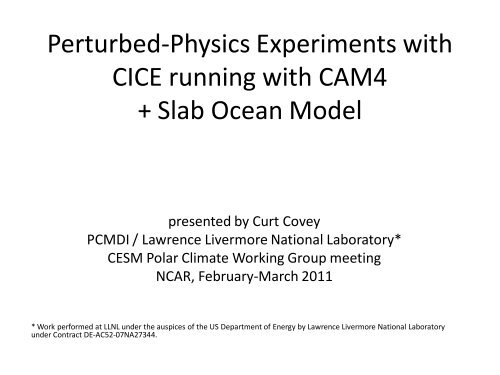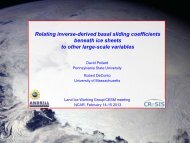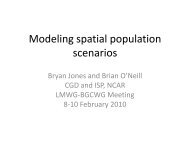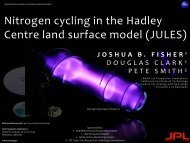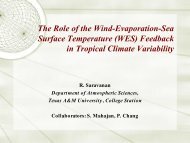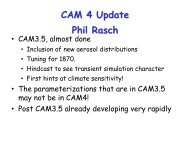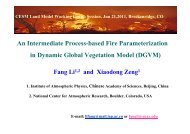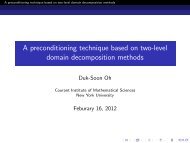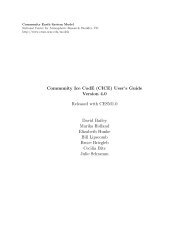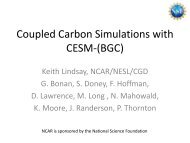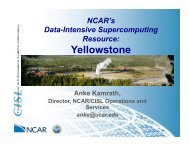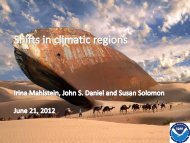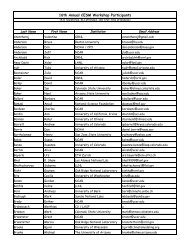Curt Covey - CESM | Community Earth System Model
Curt Covey - CESM | Community Earth System Model
Curt Covey - CESM | Community Earth System Model
You also want an ePaper? Increase the reach of your titles
YUMPU automatically turns print PDFs into web optimized ePapers that Google loves.
Perturbed-Physics Experiments with<br />
CICE running with CAM4<br />
+ Slab Ocean <strong>Model</strong><br />
presented by <strong>Curt</strong> <strong>Covey</strong><br />
PCMDI / Lawrence Livermore National Laboratory*<br />
<strong>CESM</strong> Polar Climate Working Group meeting<br />
NCAR, February-March 2011<br />
* Work performed at LLNL under the auspices of the US Department of Energy by Lawrence Livermore National Laboratory<br />
under Contract DE-AC52-07NA27344.
… and showing results from:<br />
• Scott Brandon (LLNL Weapons and Complex-Integration)<br />
• David Domyancic (LLNL Computing / Applications, Simulations and Quality Division)<br />
• Gardar Johannesson (LLNL National Security Engineering Division)<br />
• Steve Klein (LLNL PCMDI / Atmospheric, Energy and <strong>Earth</strong> Division)<br />
• Richard Klein (LLNL Weapons and Complex-Integration, group leader for Verification<br />
and Validation; and UC Berkeley Astronomy Department)*<br />
• Donald Lucas (LLNL Atmospheric, Energy and <strong>Earth</strong> Division)<br />
• John Tannahill (LLNL Global Security Computing)<br />
• Yuying Zhang (LLNL PCMDI / Atmospheric, Energy and <strong>Earth</strong> Division)<br />
* R. Klein is PI for LLNL’s Strategic Initiative project “The Advance of UQ Science with Application<br />
to Climate <strong>Model</strong>ing, Inertial-Confinement Fusion Design, and Stockpile Stewardship Science.”<br />
NB: Sea ice results are very preliminary – runs still in<br />
progress. All opinions herein are <strong>Curt</strong>’s, not necessarily<br />
everyone’s in the project.
Summary of Perturbed-Physics Experiments with<br />
CAM4 run in AMIP Mode*<br />
• 28 uncertain input parameters identified (“expert elicitation”)<br />
• The challenge: if we consider 3 possible values for each,<br />
• How to sample? Choice of input-parameter variations? See<br />
AMWG and Breckenridge talks by Lucas, Brandon, Tannahill.<br />
• 2,937 12-year AMIP simulations 43 Tbytes output<br />
– Bigger than CMIP3 / IPCC AR4 database of climate model output<br />
– Needs similar worldwide accessibility to be fully analyzed<br />
* Note earlier PPEs of CAM3 in both AMIP and SOM mode by:<br />
C. Jackson et al., J Climate 21: 6698 (2008)<br />
B. Sanderson, J Climate (in press)
Summary of Perturbed-Physics Experiments with<br />
CAM4 run in AMIP Mode (continued)<br />
Varying 27 uncertain input parameters:*<br />
(95% confidence range<br />
per <strong>Covey</strong> and Klein 2010)<br />
Result from default input-parameter values<br />
r = −0.96<br />
slope = −280 W/m2<br />
intercept = 84 W/m2<br />
*Varying 28 parameters:<br />
r = −0.95<br />
slope = −290 W/m2<br />
intercept = 89 W/m2
CICE contributes 7 additional uncertain<br />
input parameters:<br />
name low default high description .F90 subroutine<br />
1 dt_mlt_in 0.10 1.50 1.80 Temperature at which<br />
ice melt begins [°C]<br />
2 r_ice -1.9 0.0 1.9 Sea-ice albedo<br />
tuning parameter<br />
[s.d. units]<br />
3 r_pnd -1.9 0.0 1.9 Ponded-ice albedo<br />
tuning parameter<br />
[s.d. units]<br />
4 r_snw -1.9 1.5 1.9 Snow albedo tuning<br />
parameter [s.d. units]<br />
5 rsnw_melt_in 500.0 1500.0 2000.0 Maximum snow<br />
grain radius [μm]<br />
6 ksno 0.10 0.30 0.35 Thermal conductivity<br />
of snow [W / (m °C)]<br />
7 mu_rdg 3.0 4.0 5.0 With ice thickness,<br />
gives e-folding scale<br />
of ridges [m^(1/2)]<br />
ice_shortwave<br />
ice_shortwave<br />
ice_shortwave<br />
ice_shortwave<br />
ice_shortwave<br />
ice_therm_vertical<br />
ice_mechred<br />
Our thanks for extended conversations with the <strong>CESM</strong> PCWG and especially Dave<br />
Bailey, Cecilia Bitz, Bruce Breigleb, Charles Jackson, and Rich Neale.<br />
Note: We might be able to test all 2187 possible low / default / high combinations,<br />
but that would take us off the main path of our project.
First Test PPE with CAM4+SOM+CICE:<br />
1 st year planetary albedo = 0.40<br />
All 36 input<br />
parameters set to:<br />
Low values<br />
Default values<br />
High values<br />
Second Test PPE: Kept CICE input parameters at default values. Same basic result.<br />
Warning: All SOM tests to date use 1°-resolution ocean heat-transport forcing with 1°resolution<br />
CAM4.
Third Test PPE: Kept CAM4 input<br />
parameters at default values.
Q: Can polar bears survive all combinations of<br />
“reasonable” CICE input-parameter values?<br />
A: Probably not.
How to avoid freezing the model <strong>Earth</strong><br />
in PPEs? Three possibilities:<br />
1. Pre-filtering: Avoid input-parameter combinations likely to freeze<br />
<strong>Earth</strong>. But how do we know what they are in advance? Stick with<br />
combinations already AMIP-tested, or interpolate in 36<br />
dimensions.<br />
2. Kill switch: Check each run early, discard if warning signs appear<br />
(e.g. if planetary albedo > 0.32).<br />
3. Traditional “flux correction” for each input-parameter<br />
combination: Adjust the prescribed ocean heat flux to whatever<br />
value keeps SST within reasonable bounds. But this will violate<br />
conservation of energy (globally averaged heat flux out of oceans<br />
> 10 W / m2 in most cases). Down-weight unrealistic cases later?<br />
Your advice is welcome!


